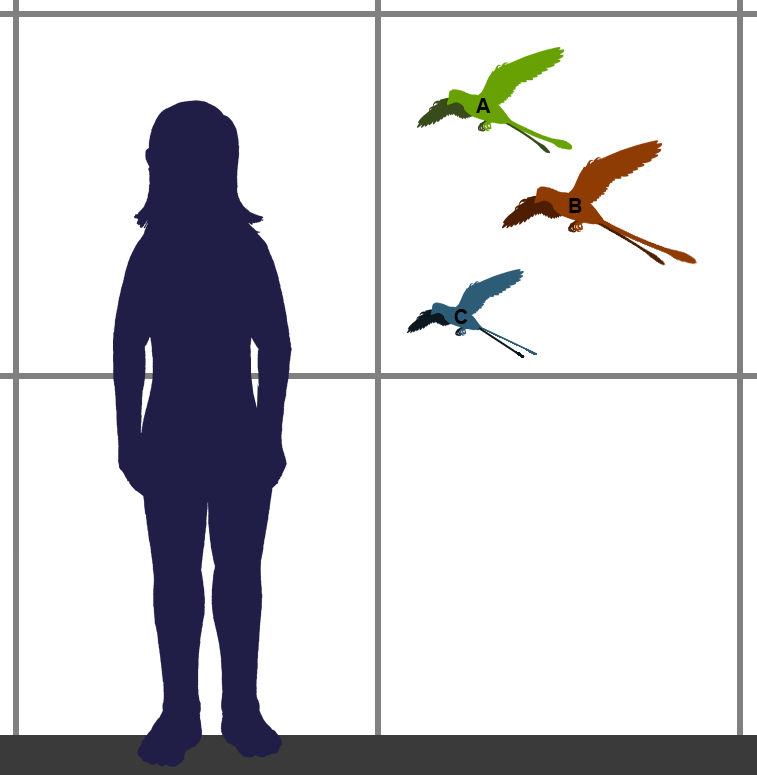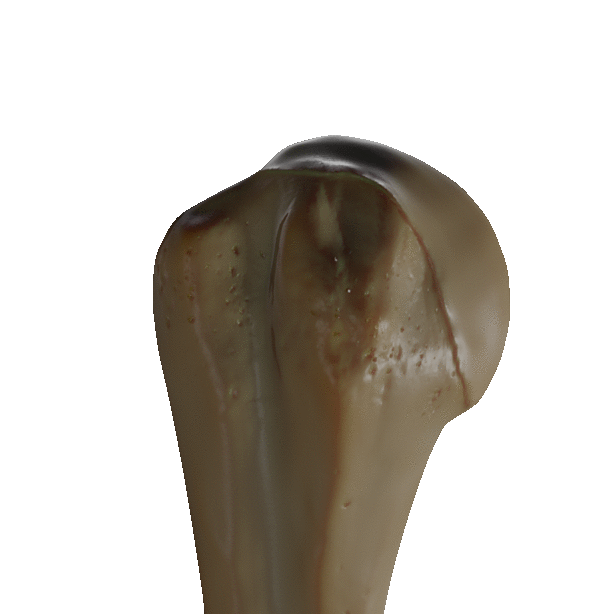|
Eoconfuciusornis
''Eoconfuciusornis'' a genus of extinct avialan that lived 131 Ma ago, in the Early Cretaceous of China. The type species of ''Eoconfuciusornis'', ''Eoconfuciusornis zhengi'', was named and described by Zhang Fucheng, Zhou Zhonghe and Michael Benton in 2008. The generic name combines a Greek ἠώς, ''eos'', "dawn", with the name of the related genus ''Confuciusornis''. The specific name honours Zheng Guangmei. The holotype, specimen IVPP V11977, was found near Sichakou in Fengning in Hebei province. Its provenance the Sichakou Beds are part of the Dabeigou Formation which was seen by the describers as dating to the Hauterivian, and were thought to be about 131 million years old. The specimen consists of a compressed skeleton that is relatively complete and shows well conserved remains of most of the feathering. ''Eoconfuciusornis'' was somewhat smaller than ''Confuciusornis'', but otherwise very similar with a pointed toothless beak. Compared to the latter it had longer ... [...More Info...] [...Related Items...] OR: [Wikipedia] [Google] [Baidu] |
Confuciusornithidae
Confuciusornithidae is an extinct family of pygostylian avialans known from the Early Cretaceous, found in northern China. They are commonly placed as a sister group to Ornithothoraces, a group that contains all extant birds along with their closest extinct relatives. Confuciusornithidae contains four genera, possessing both shafted and non-shafted (downy) feathers. They are also noted for their distinctive pair of ribbon-like tail feathers of disputed function. The wing anatomy of confuciusornithids suggests an unusual flight behavior, due to anatomy that implies conflicting abilities. They possessed feathers similar to those of fast-flapping birds, which rely on quick flapping of their wings to stay aloft. At the same time, their wing anatomy also suggests a lack of flapping ability. Confuciusornithids are also noted for their beak and lack of teeth, similar to modern birds. Both predators and prey, confuciusornithid fossils have been observed with fish remains in their digest ... [...More Info...] [...Related Items...] OR: [Wikipedia] [Google] [Baidu] |
Confuciusornis
''Confuciusornis'' is a genus of basal crow-sized avialan from the Early Cretaceous Period of the Yixian and Jiufotang Formations of China, dating from 125 to 120 million years ago. Like modern birds, ''Confuciusornis'' had a toothless beak, but closer and later relatives of modern birds such as '' Hesperornis'' and ''Ichthyornis'' were toothed, indicating that the loss of teeth occurred convergently in ''Confuciusornis'' and living birds. It is the oldest known bird to have a beak. It was named after the Chinese moral philosopher Confucius (551–479 BC). ''Confuciusornis'' is one of the most abundant vertebrates found in the Yixian Formation, and several hundred complete specimens have been found. History of discovery In November 1993, the Chinese paleontologists Hou Lianhai and Hu Yoaming of the Institute of Vertebrate Paleontology and Paleoanthropology (IVPP) at Beijing, visited fossil collector Zhang He at his home in Jinzhou, where he showed them a fossil bird specimen ... [...More Info...] [...Related Items...] OR: [Wikipedia] [Google] [Baidu] |
2008 In Paleontology
Protozoa New taxa Plants Angiosperms Monocots Arthropoda Arachnids Insects Xiphosurans Fishes Bony fish Placoderms General research *Hilton & Grande redescribe the fossil mooneyes of western North America synonymizing the genus ''Eohiodon'' with ''Hiodon''. *Cicimurri, Paris, & Everhart describe a partial dentition from a Holocephali chimaeroid fish found in the Niobrara Chalk. Amphibians Jenkins, F. A., jr, Shubin, N. H., Gatesy, S. M., and Warren, A., 2008, Gerrothorax pulcherrimus from the Upper Triassic Fleming Fjord Formation of East Greenland and a reassessment of head lifting in temnospondyl feeding: Journal of Vertebrate Paleontology, v. 28, n. 4, p. 935-950. Newly named amphibians Archosaurs Newly named pseudosuchians Newly named pterosaurs Dinosaurs * Oviraptorosaurian eggs with embryonic skeletons are discovered for the first time in China. * Mongolian Late Jurassic theropod fossils are found for the first time. * A new study on ... [...More Info...] [...Related Items...] OR: [Wikipedia] [Google] [Baidu] |
Dabeigou Formation
The Dabeigou Formation is a palaeontological formation located in Hebei, China.Dabeigou Formation at .org It dates from the mid to of the |
Early Cretaceous
The Early Cretaceous (geochronological name) or the Lower Cretaceous ( chronostratigraphic name), is the earlier or lower of the two major divisions of the Cretaceous. It is usually considered to stretch from 145 Ma to 100.5 Ma. Geology Proposals for the exact age of the Barremian-Aptian boundary ranged from 126 to 117 Ma until recently (as of 2019), but based on drillholes in Svalbard the defining early Aptian Oceanic Anoxic Event 1a (OAE1a) was carbon isotope dated to 123.1±0.3 Ma, limiting the possible range for the boundary to c. 122–121 Ma. There is a possible link between this anoxic event and a series of Early Cretaceous large igneous provinces (LIP). The Ontong Java- Manihiki- Hikurangi large igneous province, emplaced in the South Pacific at c. 120 Ma, is by far the largest LIP in Earth's history. The Ontong Java Plateau today covers an area of 1,860,000 km2. In the Indian Ocean another LIP began to form at c. 120 Ma, the Kergue ... [...More Info...] [...Related Items...] OR: [Wikipedia] [Google] [Baidu] |
Fengning
Fengning Manchu Autonomous County (; Manchu: ; Mölendroff: fengning manju beye dasangga siyan) is a Manchu autonomous county of northern Hebei province, bordering Beijing to the southwest and Inner Mongolia to the north, and lying under the administration of the prefecture-level city of Chengde. It is the second-largest county of Hebei in terms of area, after the neighbouring Weichang Manchu and Mongol Autonomous County. Administrative divisions The county has 9 towns, 16 townships, and one ethnic township under its administration. Geography Geology Fossil-bearing rocks of the Mesozoic Huajiying Formation and/or Yixian Formation occur on the surface. The prehistoric bird '' Paraprotopteryx'' was found in such a deposit. Climate Fengning has a rather dry, monsoon-influenced humid continental climate ( Köppen ''Dwa''), with long, very cold and dry winters, and hot, humid summers, and the elevation depresses temperatures. The monthly 24-hour mean temperature in January is , ... [...More Info...] [...Related Items...] OR: [Wikipedia] [Google] [Baidu] |
Fossil Taxa Described In 2008
A fossil (from Classical Latin , ) is any preserved remains, impression, or trace of any once-living thing from a past geological age. Examples include bones, shells, exoskeletons, stone imprints of animals or microbes, objects preserved in amber, hair, petrified wood and DNA remnants. The totality of fossils is known as the ''fossil record''. Paleontology is the study of fossils: their age, method of formation, and evolutionary significance. Specimens are usually considered to be fossils if they are over 10,000 years old. The oldest fossils are around 3.48 billion years old to 4.1 billion years old. Early edition, published online before print. The observation in the 19th century that certain fossils were associated with certain rock strata led to the recognition of a geological timescale and the relative ages of different fossils. The development of radiometric dating techniques in the early 20th century allowed scientists to quantitatively measure the ... [...More Info...] [...Related Items...] OR: [Wikipedia] [Google] [Baidu] |
Early Cretaceous Birds Of Asia
Early may refer to: History * The beginning or oldest part of a defined historical period, as opposed to middle or late periods, e.g.: ** Early Christianity ** Early modern Europe Places in the United States * Early, Iowa * Early, Texas * Early Branch, a stream in Missouri * Early County, Georgia Other uses * ''Early'' (Scritti Politti album), 2005 * ''Early'' (A Certain Ratio album), 2002 * Early (name) * Early effect, an effect in transistor physics * Early Records, a record label * the early part of the morning Morning is the period from sunrise to noon. There are no exact times for when morning begins (also true of evening and night) because it can vary according to one's lifestyle and the hours of daylight at each time of year. However, morning stric ... See also * Earley (other) {{disambiguation, geo ... [...More Info...] [...Related Items...] OR: [Wikipedia] [Google] [Baidu] |
Humerus
The humerus (; ) is a long bone in the arm that runs from the shoulder to the elbow. It connects the scapula and the two bones of the lower arm, the radius and ulna, and consists of three sections. The humeral upper extremity consists of a rounded head, a narrow neck, and two short processes (tubercles, sometimes called tuberosities). The body is cylindrical in its upper portion, and more prismatic below. The lower extremity consists of 2 epicondyles, 2 processes (trochlea & capitulum), and 3 fossae (radial fossa, coronoid fossa, and olecranon fossa). As well as its true anatomical neck, the constriction below the greater and lesser tubercles of the humerus is referred to as its surgical neck due to its tendency to fracture, thus often becoming the focus of surgeons. Etymology The word "humerus" is derived from la, humerus, umerus meaning upper arm, shoulder, and is linguistically related to Gothic ''ams'' shoulder and Greek ''ōmos''. Structure Upper extremity The upper or pr ... [...More Info...] [...Related Items...] OR: [Wikipedia] [Google] [Baidu] |
Hauterivian
The Hauterivian is, in the geologic timescale, an age in the Early Cretaceous Epoch or a stage in the Lower Cretaceous Series. It spans the time between 132.9 ± 2 Ma and 129.4 ± 1.5 Ma (million years ago). The Hauterivian is preceded by the Valanginian and succeeded by the Barremian.See Gradstein ''et al.'' (2004) for a detailed geologic timescale Stratigraphic definitions The Hauterivian was introduced in scientific literature by Swiss geologist Eugène Renevier in 1873. It is named after the Swiss town of Hauterive at the shore of Lake Neuchâtel. The base of the Hauterivian is defined as the place in the stratigraphic column where the ammonite genus '' Acanthodiscus'' first appears. A reference profile for the base (a GSSP) was officially ratified by the International Union of Geological Sciences in December of 2019, and is placed in La Charce, France. The top of the Hauterivian (the base of the Barremian) is at the first appearance of ammonite species ''Spitidis ... [...More Info...] [...Related Items...] OR: [Wikipedia] [Google] [Baidu] |



